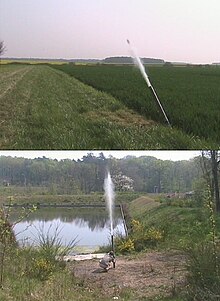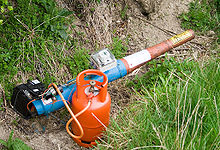T-shirt cannon
A potato cannon, also known as a potato gun or potato launcher, is a pipe-based cannon that uses air pressure (pneumatic), or combustion of a flammable gas (aerosol, propane, etc.),[1][2][3][4] to fire projectiles, usually potatoes.[5] A simple design consists of a pipe sealed on one end, with a reducer on the other end to lower the diameter of the pipe, which has the corresponding lower-diameter pipe attached to it, called the barrel. Generally, the operator loads the projectile into the barrel, then utilizes a fuel or air pressure (or sometimes both) to propel the projectile out of the cannon.
The potato cannon can trace its origin to the World War II-era Holman Projector, which was a shipboard anti-aircraft weapon.[6]
Operation methods
Combustion
Combustion powered potato cannons typically have the least complex designs; the four basic elements of which are:
- A fuel-air mixture
- A combustion chamber
- An ignition source
- A barrel
In order to fire, the operator loads a projectile into the barrel, adds fuel to the combustion chamber (for example aerosols or propane), and triggers the ignition source (often using a piezoelectric barbecue igniter). The fuel-air mixture then ignites, creating hot expanding gases which force the projectile out of the barrel. The range of the cannon depends on many variables, including the type of fuel used, the efficiency of the fuel/air ratio, the combustion chamber/barrel ratio, and the flight characteristics of the projectile. Common distances vary from 100–200 meters (330–660 feet), and there is a reported case of a cannon exceeding 500 meters (1,600 feet) of range.[7]
Pneumatic


The range of pneumatic cannons is more variable than the range of combustion potato cannons due to the increased variation possible in the components. Typical ranges are slightly higher because of the greater power, but the maximum range of some high power pneumatic cannons has been said to be over 1,000 metres (3,300 ft).[8]
Hybrid
In order to fire, the operator first readies the pressure-triggered valve then injects several times the normal amount of fuel and appropriately more air. When the ignition source is triggered, the pressure from the combustion causes the main valve to open and propels the projectile out of the barrel with the released combustion gases. The hybrid is capable of higher velocities than a combustion or pneumatic potato cannon because the pressure generated is higher than that in a combustion gun (for most fuels), and the shock wave moves faster than it can in a pneumatic (for most gases), due to the higher temperature. Projectiles fired by a hybrid have broken the sound barrier.[9]
Dry ice

The oldest examples simply involve dropping pieces of dry ice into a tube closed at one end and sealing the other end by jamming the projectile in. When the pressure of the carbon dioxide from the subliming dry ice builds high enough, the projectile will be blown out of the tube.[10]
Vacuum
Primary materials
Plastics
- PVC-U (Polyvinyl chloride, unplasticized): Highly popular due to its availability and relatively low cost. PVC pipes are available in a wide variety of sizes and pressure ratings. In industry, however, they are illegal for compressed air applications—if they are damaged under pressure the plastic can fail explosively.[11]
- ABS (Acrylonitrile butadiene styrene): Another popular plastic piping material, more expensive and less common than PVC but available in the same sizes and pressure ratings. Unlike PVC it is used in compressed air systems as it splits rather than shatters on failure.[12]
Metals
- Brass: Often brass fittings are used on potato cannons for small parts of the construction like fuel systems, because it is one of the most common materials for small pipe fittings. Occasionally large parts of potato cannons are machined entirely out of brass.[13]
Valve types
Pneumatic
- The Quick Dump Valve is a recent addition to the choices of valves for spudding. A QDV is a spool valve that is balanced under pressure with one end of the spool oriented toward the barrel. The spool is manually unbalanced allowing pressure between the end of the spool and the projectile in the barrel. The air pressure then forces the spool back and the projectile forward. Since the valve is triggered with no pilot pressure, the valve snaps open with no pilot pressure to hinder it. Currently it is not commercially for sale and must be hand built by the hobbyist like most piston valves.[14]
Alternate designs have also been used which use a sharp projectile to puncture the burst disk, like a mortar[15] or using a manual puncturing device to trigger failure of the disk.[16]
- Burst disk cannons have also been made which are fired electrically, using a nichrome wire to trigger failure by heating.[17]
Connections
Welding, soldering and gluing
- Solvent welding: used for similar plastic connections using solvent fittings, the solvent temporarily dissolves the polymer chains of the plastic and the parts to be joined are brought together. On rehardening, the polymer chains from each part are entangled and so form a solid weld.[18]
The sound barrier
It is rare for a potato cannon to be powerful enough to break the sound barrier, although there are some cases of this happening using specialized designs. The potato cannons used are typically hybrids; but some pneumatic cannons have achieved the feat, either by using a special low-density gas, such as helium,[19] or high pressures combined with a fast valve.[20] There is also one reported case of a combustion design achieving super-sonic velocities.[7]
The highest projectile speed recorded from a potato cannon is 933.3 m/s (3,060 ft/s) (approximately 2.7 times the speed of sound) with a 16.6-gram (256 gr) 20 mm plastic slug from a hybrid using a 20 MPa (2,900 psi) pre-ignition mixture of air and propane.[21]
Supersonic velocities have been obtained using the related vacuum bazooka with a de Laval nozzle. This also relies on significantly lowering the density of the gas.[22]
Practical uses
Although potato cannons are created and used for the purpose of recreation there are other devices which work on identical principles in many other fields with more serious uses.
Entertainment
- Promotional sports cannons: Portable pneumatic cannons which run on bottled CO2 are common at large sports games in the U.S. where they are used to project items such as T-shirts or wrapped food into the audience. Such cannons can be dangerous: the Phillie Phanatic injured a fan with a hot dog cannon in June 2018.[23]
Industry

- Shock tubes: used to test hypersonic and supersonic combustion ramjets.[24]
Safety
Potato cannons by nature are hazardous and can present safety issues if poorly constructed or used. Projectiles or failing guns can be dangerous and result in life-threatening injuries, including cranial fractures, enucleation, and blindness if a person is hit.[25]
See also
- Air gun – Gun that uses compressed air to launch projectiles
- FN 303 – type of Riot gun
- Paintball marker – Air gun used in the shooting sport of paintball
- Plastic pipework – Tubular section or hollow cylinder made of plastic
- Pneumatic weapon – projectile weapon which uses pressurized air
- Punkin chunkin – Sport of hurling a pumpkin mechanically
References
- ^ Mungan, Carl E. (May 2009). "Internal ballistics of a pneumatic potato cannon". European Journal of Physics. 30 (3): 453–457. Bibcode:2009EJPh...30..453M. doi:10.1088/0143-0807/30/3/003. S2CID 35147997.
- ^ Ayars, Eric; Bucholtz, Louis (July 2004). "Analysis of the vacuum cannon". American Journal of Physics. 72 (7): 961–963. Bibcode:2004AmJPh..72..961A. doi:10.1119/1.1710063. Retrieved 15 August 2011.
- ^ Pierson, Hazel M.; Price, Douglas M. (Spring 2005). "The Potato Cannon: Determination of Combustion Principles for Engineering Freshmen" (PDF). Chemical Engineering Education. 39 (2): 156–159. Retrieved 15 August 2011.[permanent dead link]
- ^ Courtney, Michael; Courtney, Amy (November 2007). "Acoustic Measurement of Potato Cannon Velocity". The Physics Teacher. 45 (8): 496–7. arXiv:physics/0612118. Bibcode:2007PhTea..45..496C. doi:10.1119/1.2798362. S2CID 119057813. Archived from the original on 2012-07-16. Retrieved 15 August 2011.
- ^ Gurstelle, William (2001). Backyard Ballistics: Build Potato Cannons, Paper Match Rockets, Cincinnati Fire Kites, Tennis Ball Mortars, and More Dynamite Devices. Chicago: Chicago Review Press. ISBN 1-55652-375-0. OCLC 45861947. Backyard Ballistics at Google Books.
- ^ How the Humble Potato Cannon Served the Allies in World War Two Popular Mechanics, Retrieved April 4, 2017.
- ^ a b BigBang (October 2006). "Crusader". SpudFiles. Archived from the original on 20 February 2009. Retrieved 2009-06-01.
- ^ schmanman; et al. (March–April 2007). "(NEW) S.W.A.T v.3". SpudFiles. Archived from the original on 2 February 2013. Retrieved 16 August 2011. Cannon with a calculated range exceeding 1 mile.
- ^ Killjoy (25 April 2007). "FEAR". SpudFiles. Archived from the original on 27 February 2015. Retrieved 2009-06-01.
- ^ Van Horn, Dale R. (October 1932). "Perform These STARTLING STUNTS with DRY ICE". Modern Mechanix and Inventions: 114–116. Retrieved 15 August 2011.
- ^ "OSHA Safety Hazard Information Bulletin on the Use of Polyvinyl Chloride (PVC) Pipe in Above ground Installations". Occupational Safety and Health Administration. 20 May 1988. Retrieved 16 August 2011.
- ^ Arabe, Katrina C. (23 April 2001). "A Dynamic Duo: Thermoplastics and Compressed Air Systems". Industry Market Trends. ThomasNet News. Retrieved 16 August 2011.
- ^ Novacastrian (November 2007). "The Brass Bruiser". SpudFiles. Retrieved 2009-06-01.
- ^ Technician1002 (4 April 2009). "Quick Dump Valve". SpudFiles. Retrieved 16 August 2011.
{cite web}: CS1 maint: numeric names: authors list (link) - ^ Downie, Neil (2006). Exploding Disk Cannons, Slimemobiles, and 32 Other Projects for Saturday Science. The Johns Hopkins University Press. p. 5. ISBN 9780691149660.
- ^ Downie, Neil (2012). The Ultimate Book of Saturday Science : The Very Best Backyard Science Experiments You Can Do Yourself. Princeton University Press. p. 411. ISBN 9780691149660.
- ^ Downie, Neil (2012). The Ultimate Book of Saturday Science : The Very Best Backyard Science Experiments You Can Do Yourself. Princeton University Press. pp. 407–408. ISBN 9780691149660.
- ^ Wise, Roger (2003-10-29). "Solvent welding of thermoplastics". TWI. Archived from the original on 2008-02-12. Retrieved 2009-06-01.
- ^ "New stuff". The Spudgun Technology Center. 14 January 2010 [6 July 2002]. Retrieved 16 August 2011.
"Theory/physics behind the spudgun". The Spudgun Technology Center. 29 August 2008 [25 June 2002]. Retrieved 16 August 2011. Used helium to attain supersonic velocities. - ^ jackssmirkingrevenge (8 September 2007). "high velocity burst disc 6mm pneumatic". SpudFiles. Retrieved 16 August 2011. Attained approximately Mach 1 (340 m/s; 1120 ft/s) with 400 psi (2.8 MPa) and a fast valve.
- ^ Larda (31 July 2008). "Lardas First Hybrid - HyGaC20". SpudFiles. Archived from the original on 15 September 2012. Retrieved 2009-06-01.
- ^ Didymus, JohnThomas (2013-02-06). "Video: Supersonic Ping-Pong gun fires a ball faster than sound". Digital Journal. Retrieved 2013-10-21.
- ^ "Phillie Phanatic's hot dog cannon sends Phillies fan to emergency room". 21 June 2018.
- ^ "T4 Shock Tunnel". Centre for Hypersonics, The University of Queensland. Retrieved 16 August 2011.
- ^ Barker-Griffith, Ann E.; Streeten, Barbara W.; Abraham, Jerrold L.; Schaefer, Daniel P.; Norton, Sylvia W. (1 March 1998). "Potato gun ocular injury". Ophthalmology. 105 (3): 535–538. doi:10.1016/S0161-6420(98)93039-1. PMID 9499787. Retrieved 15 August 2011.
External links
- How Pneumatic Potato Cannons Work —Audio slideshow from the National High Magnetic Field Laboratory
- potato cannon building instructions — potato cannon plans, animations, construction how-tos
 Media related to Potato cannons at Wikimedia Commons
Media related to Potato cannons at Wikimedia Commons